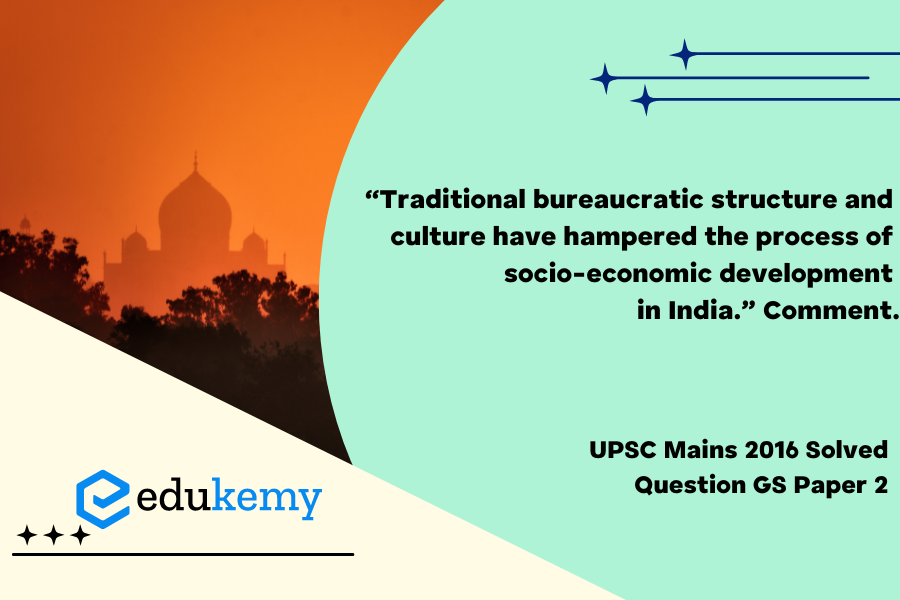India, with its rich history and diverse cultural tapestry, has long grappled with the impact of traditional bureaucratic structure and cultures on its path to socio-economic development. The bureaucratic framework, inherited from colonial times, is often criticized for its inefficiency, red tape, and hierarchical nature, which impede the swift execution of policies and initiatives. The rigid structures within government institutions create bottlenecks, hindering the implementation of innovative ideas and reforms necessary for fostering economic growth. Additionally, the prevailing bureaucratic culture tends to resist change and favors adherence to established norms, limiting adaptability in a rapidly evolving global landscape. This resistance, in turn, constrains the country’s ability to address pressing socio-economic challenges and harness the full potential of its dynamic and youthful population. The bureaucratic machinery, designed for control and stability, faces challenges in responding effectively to the demands of a modern, fast-paced society. Consequently, there is a growing recognition that reforming the traditional bureaucratic structure and fostering a more agile and responsive culture are essential for unlocking India’s socio-economic potential and ensuring sustained development in the 21st century.
Tag: Role of civil services in a democracy.
Contents
Decoding the Question:
- In the Introduction, try to briefly about Indian bureaucracy.
- In Body,
- Discuss how traditional bureaucratic structure and culture have hampered the process of socio-economic development.
- Can suggest some reforms to strengthen bureaucracy.
- In Conclusion, try to write about the overall importance of Indian bureaucracy and suggest some reforms.
Answer:
The structure of administration in India is modeled based on the British system of civil services; it is called by Sardar Patel as the steel frame. It is a crucial pillar in the governance of the nation. Articles 308 to 314 in part XIV of the Constitution contain provisions about Indian bureaucracy. The bureaucracy is a crucial pillar of the Indian state and has been given the responsibility for administering the country. It was supposed to participate in the socio-economic development of the nation.

Problems with Indian Bureaucracy:
- Corruption: Bureaucratic structure has been criticized for the strong protection it provided under the constitution Article 311. It has acted as shield for bureaucracy which led to lack of accountability and transparency. This has also been the cause of rising business-political-bureaucratic nexus and consequently wide spread corruption and, hence, hampered the process of socio economic development.
- Political interference: Sometimes there is “unholy” nexus between unscrupulous politicians and officers leading to poor governance. Transfer and location posting being in control of political leaders bent the working based on performance to appease the politician of the day.
- Red Tapism: Red Tapism and unnecessary complex procedures add to the hardship of citizens. It has made doing business in India a difficult task. Development has been hindered by delays in processing and approval of the project.
- Grievance redressal: There is a perceptible lack of commitment in public servants towards redressal of citizens’ grievances. Lack of empathy, and indifferent attitude towards the public are still present in the bureaucratic structure. This has hampered the process of inclusive development as bureaucracy hasn’t been able to redress public grievances completely.
- Lack of coordination: Bureaucracy has been mired by a lack of coordination among various services. The interservice rivalry between IAS, IPS, and IRS exists with special preference in compensation and powers to IAS. This is a constant source of social tensions while working together.
- Rigid hierarchy: Hierarchy in bureaucracy slows down the implantation of policies & decision-making. Government servants are rarely held to account and complaints to higher authorities usually go unheeded. Frequent transfer of officers reduces their effectiveness and also dilutes their accountability.
Measures to Strengthen the Bureaucratic System:
- The 2nd ARC report has pointed out the need to make citizen-centric administration a Priority to make the administration pro-poor.
- Civil servants can be encouraged by inking service conditions with outcomes and reforming policies to appreciate proactive behavior.
- Outcome or result-oriented, participatory responsive, and focused bureaucracy can bring efficiency and effectiveness in policy-making and implementation.
- A bottom-up approach and sensitization of bureaucracy can make traditional bureaucracy more ethical, compassionate, and responsible.
The bureaucrats have struggled to change their mindset to the new scenario after independence. The needs of the current administration have grown in complexity and require specialization for effective governance. Recent steps of the government like Mission Karmyogi, lateral entry, etc., are important in making bureaucrats more imaginative and innovative, proactive and polite, professional and progressive, energetic and enabling, transparent and tech-enabled, constructive and & creative to meet the challenges of New India.
In case you still have your doubts, contact us on 9811333901.
For UPSC Prelims Resources, Click here
For Daily Updates and Study Material:
Join our Telegram Channel – Edukemy for IAS
- 1. Learn through Videos – here
- 2. Be Exam Ready by Practicing Daily MCQs – here
- 3. Daily Newsletter – Get all your Current Affairs Covered – here
- 4. Mains Answer Writing Practice – here


